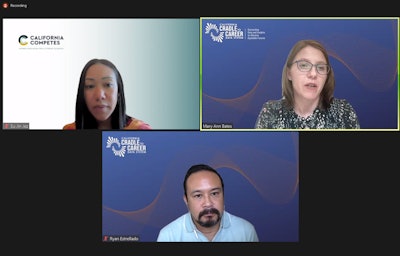The importance of accounting for an intended audience when designing a system is but one of the lessons panelists shared during a webinar hosted by California Competes Monday.

User-Centered Design (UCD), a product design approach that centers on researching intended users, getting feedback from them, and iterating on the product, was central to how the higher ed nonprofit developed its California Postsecondary to Prosperity Dashboard, an education statistics resource for the state.
Now, the organization has released a brief about that experience and how the state of California can learn from it to continue integrating UCD into its own upcoming California Cradle-to-Career Data System (C2C).
A result of enacting the California Cradle-to-Career Data System Act in 2019, the C2C is meant to be a statewide education data system that brings together information on education, social services, and workforce matters into one cohesive product, said Dr. Su Jin Jez, CEO of California Competes.
The panelists discussed C2C’s goals and how it employed UCD in its development.
"California has a number of regions, cities, areas, that hold an enormous amount of wealth and opportunity. But that's not the reality for other parts of our state,” Jez said. “We're at once one of the world's largest economies and also have the highest poverty rate in the nation. Data enables us to peel back the layers, get on a granular level on how our systems are and are not yet equitably serving all of our residents and communities."
Data about programs, schooling levels, and employment has historically been disconnected and siloed, said Mary Ann Bates, C2C’s executive director. But C2C seeks to create a linked data set, using state-level data collected and validated by a number of different providers. The data will first be shared with C2C this fall, with data for the prior academic year provided to C2C every March from then on, Bates said.
C2C will present this data to users – whether they be families, students, policy planners – via a public dashboard and will have a data request process for researchers, Bates added.
UCD involves finding out what users want and need prior to product development. In its brief, California Competes advises: “The C2C team should consider making data available in a variety of formats and the appropriate descriptive contexts so that, no matter their familiarity with the data, various users can easily glean the pertinent information they need and accomplish their respective goals.”
C2C plans on providing training and other supports to ensure that these resources are actually usable and useful, Bates said.
"We need to make sure that we're doing this work by engaging with communities and listening to their needs first before we even release products, before we develop them, and really ensure that user-centered design is at the heart of what we're doing," Bates said. "If the information we put out isn't accessible to and useful for California's diverse communities, we won't have succeeded.”
 Mary Ann Miller Bates
Mary Ann Miller Bates
"If we think of equity as creating opportunities for people to participate in the process that historically haven't had a chance to participate, you can then see, for very practical reasons, why user-centered design can be a powerful tool for equity,” Estrellado said. “Because at every stage of the design process, ... each of those is an opportunity to be very thoughtful about who you invite into that process to co-design with you."
Estrellado said that some users, such as students, can be hard to reach. He cited special circumstances such as being undocumented or not having a steady residence due to being in foster care, as potential reasons.
“To participate in any sharing of information is a vulnerable act for a number of reasons,” Estrellado said. “There are a lot of reasons why some folks could be hard to reach. Some of them are because of self-preservation or wanting to progress in a way that doesn't put themselves at risk. It's not always that folks don't want to participate. From our point of view, it's on us to create ways to design with and give input that are safe and as respectful of that point of view."





















